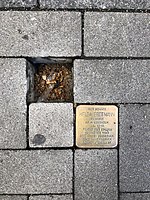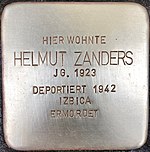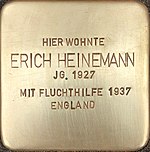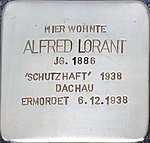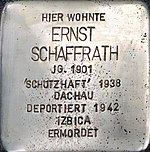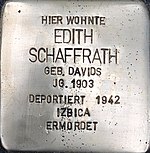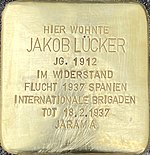List of stumbling blocks in Krefeld
The Stolpersteine in Krefeld are part of a Europe-wide project by the artist Gunter Demnig . The stumbling blocks are memorials that are supposed to remind of the fate of the people who lived in Krefeld and who were deported by the National Socialists and murdered in concentration and extermination camps , among other places . Stolpersteine have a brass surface of 96 × 96 mm and are usually cemented into the sidewalk at the same level in front of the last freely chosen residential building of the one named on the stumbling block.
The laying began in Krefeld in December 2006. This was preceded by a tough struggle at the municipal level. Among other things, the Jewish community in Krefeld expressed concerns about the project, as it saw the dignity of the victims as endangered because they would be "trampled on". After the city council had also spoken out against the Stolpersteine campaign at the beginning of November 2005, pupils from the Kurt Tucholsky Comprehensive School carried out a petition for citizens and collected around 14,000 signatures. The result was a great response from the regional and national press. Before the start of the actual citizens' initiative, the representatives agreed on a compromise so that the project could start. At the end of 2008, 41 stumbling blocks had been laid in Krefeld; Most recently, nine more stones were added on November 14, 2019, so that their number in Krefeld has meanwhile grown to 156 pieces. All of them were commissioned by the sculptor Michael Friedrichs-Friedlaender in Berlin and installed by Gunter Demnig.
Friedrich Lewerentz
| Friedrich Lewerentz | ||
|---|---|---|
| inscription | FRIEDRICH LEWERENTZ JG LIVED HERE . 1875 ARRESTED 08/22/1944 Gestapo BONDING KZ SACHSENHAUSEN 1944 DEATH MARCH TOT 1945 |

|
| Location | Hammerschmidtplatz 1 |
|
| Initiator, founder or client | SPD Krefeld | |
| financing | donate | |
| Date of first installation | December 18, 2006 | |
| Remarks | The stumbling block is reminiscent of Friedrich “Fritz” Lewerentz , born on July 3, 1878 in Loddin .
The social democrat Friedrich Lewerentz was a member of the Krefeld city council until 1933, he was arrested by the Nazis after the Hitler assassination attempt on July 20, 1944 as part of the Gewitter action on August 22, 1944 and taken to the Anrath prison. He was later taken to the Sachsenhausen concentration camp . In April 1945 Friedrich Lewerentz died on one of the death marches of concentration camp prisoners . |
|
Else Müller
| Else Müller | ||
|---|---|---|
| inscription | ELSE MÜLLER GEB. LIVED HERE. COPPEL JG. 1894 DEPORTED 1944 THERESIENSTADT LIBERATED DEAD 1.6.1945 |

|
| Location | Roßstrasse 249 |
|
| Initiator, founder or client | Students of the Kurt Tucholsky Comprehensive School | |
| financing | donate | |
| Date of first installation | December 18, 2006 | |
| Remarks | The stumbling block is reminiscent of Else Müller geb. Koppel, born on June 1, 1894 in Krefeld.
Else Müller was Jewish and married to Fritz Müller, who belonged to the Christian faith. In September 1944, Else Müller was taken on the last transport from Krefeld, together with her daughter Ilse, to a work camp run by Organization Todt , a National Socialist construction organization for military buildings. At the beginning of 1945 she was deported to the Theresienstadt concentration camp . After the liberation by the Russian army in May 1945, Else Müller took care of the camp inmates who were sick with typhus. She contracted this disease and died a short time later. Her daughter Ilse (born in 1925) is probably one of the last survivors of those deported to forced labor in 1944. The Müller family was bombed out in their house on Roßstrasse and moved into a makeshift apartment on Uerdinger Parkstrasse. Ilse Kassel-Müller was deported on the last transport of Jews on September 17, 1944, together with her mother and her sixth month pregnant sister Lore and her husband Werner Gabelin. While her sister and brother-in-law were taken to the Theresienstadt concentration camp, Ilse, then 19, ended up with her mother for forced labor in the Nazi organization Todt in Zeitz in Saxony-Anhalt. Fritz Kassel stayed behind in Krefeld with Richard Gabelin, who was then two years old. In February 1945 Else Müller was also deported to the Theresienstadt concentration camp. There she met her daughter Lore and her husband as well as her brother and her stepmother. Lore gave birth to a boy, Thomas Gabelin, on December 21, 1944 in the concentration camp. Ilse Kassel: "That was a great miracle, because a week before that, mothers with children were sent from there to the gas chambers in the Auschwitz extermination camp." Else Müller was liberated in Theresienstadt on May 8, 1945 by troops of the Red Soviet Army. However, the liberation had the consequence that a rampant typhus epidemic quickly spread beyond the camp. Volunteers were called on. Else Müller also volunteered to care for the seriously ill. She became infected and died of the insidious disease. She died on her 51st birthday, June 1, 1945. Her body was cremated and she was given an urn grave in the cemetery of honor of the Czech nation in Theresienstadt. For years, her daughter Ilse has been remembering her mother with an obituary notice in the newspaper on June 1st. Ilse Kassel-Müller was liberated in Zeitz on April 13, 1945 by the same US unit that opened the gates of the Buchenwald concentration camp. It took her several weeks before she could make her way back to her hometown by bike, motorcycle and truck-sharing. Her father Fritz Müller was rehabilitated after the war and ran an electrical shop at Kölner Strasse 25. For 19 years he was the head master for the electrical guild. Her sister Lore Gabelin and her husband survived Theresienstadt. Ilse Müller married Helmut Kassel in 1957, who was a civil servant in the city administration. In the same year the couple moved to Dahlerdyk, where Ilse Kassel-Müller still lives today. Her husband died in 1997. |
|
Paula Billstein
| Paula Billstein | ||
|---|---|---|
| inscription | HERE LIVED PAULA BILL STONE GEB. ROTHE JG. 1877 ARRESTED 1937 MORINGEN KZ LICHTENBURG DEAD July 4, 1938 |

|
| Location | "Trample" at the former factory "Im Brahm", Ritterstrasse 189 |
|
| Initiator, founder or client | The Greens, Krefeld | |
| financing | The green | |
| Date of first installation | December 18, 2006 | |
| Remarks | The stumbling block is reminiscent of Paula Billstein geb. Rothe, born on October 2, 1877 in Krefeld.
Paula Rothe was married to the worker Wilhelm Billstein. Together they had two sons ( Aurel and Wilhelm) and a daughter (Josefine). The family lived in a cooperative apartment on Ritterstrasse. From 1924 to 1933 Paula Billstein was a city councilor for the KPD in Krefeld. Her son Aurel was also politically active for the KPD and wanted to run for the Reichstag or the Prussian state parliament. With the takeover of the Nazis ended her political career. Son Aurel was taken to the Sonnenburg concentration camp in 1933 and after his release he was under further observation by the Gestapo . Since Aurel Billstein continued to be involved in the KPD and was denounced, he was sentenced in 1934 to seven years in prison. Paula Billstein was also targeted by the Gestapo through a confidential letter to her son and was arrested in 1937. Paula Billstein was brought to the women's concentration camp in Moringen on January 19, 1938 and transferred to the Lichtenburg women's concentration camp on March 21, 1938 . Paula Billstein fell seriously ill while in a concentration camp. On June 29, 1938 she was released because of "illness" and picked up there by her daughter Josefine. Paula Billstein died a few days after her release on July 4, 1938 in Krefeld. Son Aurel was still doing military service in the Penal Division 999 and was taken prisoner by the Soviets. He returned to Krefeld in 1947 and was again involved in local politics. In 1990 he was made honorary citizenship of the city of Krefeld. He died on February 12, 1996 in Krefeld. Daughter Josefine died in 1945 when forced laborers from the Soviet Union tried to steal an accordion from her ... |
|
Eugen Frank and Luise Frank
| Eugen Frank and Luise Frank | ||
|---|---|---|
| inscription | EUGEN FRANK JG LIVED HERE . DEPORTED 1884 1942 IZBICA ??? LUISE FRANK GEB. LIVED HERE WALLERSTEIN JG. DEPORTED 1882 1942 IZBICA ??? |
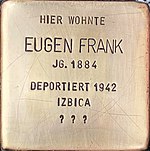 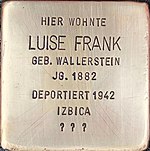
|
| Location | Alte Friedrichstrasse 11, (today Friedrichstrasse / corner of St.-Anton-Strasse) |
|
| Initiator, founder or client | ||
| financing | ||
| Date of first installation | February 16, 2007 | |
| Remarks | The stumbling blocks are reminiscent of:
The businessman Eugen Frank was married to Luise Wallerstein and they had two children together (Helmut and Suse). Eugen Frank lived with his family in Krefeld and was a board member of the Jewish religious association. In 1940 he was responsible for looking after the clothing store, to which other locations were also connected. He and his wife were deported to the Izbica ghetto on April 22, 1942 . There their trail is lost |
|
Arthur Daniels, Marta Daniels, Kurt Daniels and Hannelore Daniels
| Arthur Daniels, Marta Daniels, Kurt Daniels and Hannelore Daniels | ||
|---|---|---|
| Inscriptions | ARTUR DANIELS JG LIVED HERE . 1881 DEPORTED 1941 RIGA MURDERED 5.1.1942 HERE LIVED MARTHA DANIELS GEB. SERVOS JG. 1887 DEPORTED 1941 RIGA ??? KURT DANIELS JG LIVED HERE . 1914 ESCAPED 1939 ENGLAND SURVIVED HANNELORE DANIELS JG LIVED HERE . DEPORTED 1921 1941 RIGA SURVIVED |
 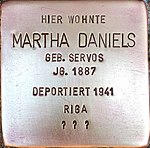  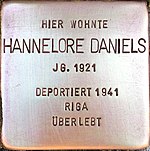
|
| Location | Issumer Strasse 7 |
|
| Initiator, founder or client | ||
| financing | ||
| Date of first installation | February 16, 2007 | |
| Remarks | The stumbling blocks are reminiscent of:
Arthur Daniels was married to Marta Servos and had two children (Kurt and Hannelore). The family lived in Krefeld-Linn as a merchant and cattle dealer. After a “protective custody” in 1938, the property was confiscated and then deported. It is also on record that “On the night of November 27/28, 1941, a woman Platen said in the air raid shelter: It is a shame that the poor Jew Daniels now has to leave Linn. For example, Daniels has 10 cows, they are now being sold and they are putting the money up there in their pockets. ”Ms. Platen then also got into trouble. Arthur and Marta Daniels were deported to the Riga ghetto on December 11, 1941 . Arthur Daniels died on January 5, 1942 in the Salaspils camp . The fate of Marta Daniels is unknown. She was declared dead on May 8, 1945 by the Krefeld District Court in 1946. |
|
Jakob Daniel, Luise Daniel and Hans Daniel
| Jakob Daniel, Luise Daniel and Hans Daniel | ||
|---|---|---|
| Inscriptions | JAKOB DANIEL JG LIVED HERE . 1885 DEPORTED 1941 RIGA ??? LUISE DANIEL JG LIVED HERE . DEPORTED 1891 1941 RIGA MURDERED 10.1.1945 STUTTHOF concentration camp HANS DANIEL JG LIVED HERE . 1922 DEPORTED 1941 RIGA ??? |
  
|
| Location | Lindenstrasse 9 |
|
| Initiator, founder or client | ||
| financing | ||
| Date of first installation | February 16, 2007 | |
| Remarks | The stumbling blocks are reminiscent of:
The businessman Jakob Daniel was married to Luise Selig and together they had two children (Lore and Hans). The family lived in Krefeld and ran a spice shop. Jakob Daniel was charged with foreign currency offenses in 1936, his passport was withdrawn in 1938 and, from November 17, 1938 to December 10, 1938, he was in “ protective custody ” in the Dachau concentration camp . On December 11, 1941, Jakob, Luise and Hans Daniel were deported to the Riga ghetto . The family's assets were confiscated when they were deported in 1941. Jakob Daniel died on May 1, 1943 in the Theresienstadt ghetto . Luise Daniel was brought to the Stutthof concentration camp on August 9, 1944 and died there on January 10, 1945. Hans Daniels' further fate is not known, he probably died in 1942 in the Riga-Salaspils camp . |
|
Karl Henning
| Karl Henning | ||
|---|---|---|
| inscription | KARL HENNING JG LIVED HERE . IN 1909 ARRIVED 1937 BUCHENWALD KZ MURDERED January 27, 1938 |
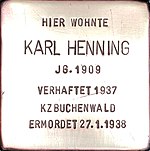
|
| Location | Oberbruchstrasse 49 |
|
| Initiator, founder or client | Jehovah's Witnesses | |
| financing | Jehovah's Witnesses | |
| Date of first installation | February 16, 2007 | |
| Remarks | The stumbling stone is reminiscent of Karl Henning , born on April 2, 1909 in Kaldenhausen .
Karl Henning lost his mother as a child. His father married a second time. The new wife, Maria Henning, had a child of their own and the two grew up as brothers. After school, Karl Henning did an apprenticeship as a fitter at the Büttner works until he was dismissed due to a lack of work. He was unemployed for a long time and dependent on changing jobs. In 1932/1933 he and his mother began to be interested in Jehovah's Witnesses. They intensified a contact and soon they considered themselves to be part of them. Unfortunately, that coincided with the time when Jehovah's Witnesses were banned. In July 1935, Karl Henning went from house to house on Dießemer Strasse and talked about the Bible and Jehovah's Witnesses. He was arrested and searched by the police - possibly due to a denunciation. Since only a handwritten advertising slip was found on him, it appeared to be a warning. A year later - in June 1936 - Karl Henning was arrested for attending meetings of Jehovah's Witnesses and sentenced to six months in prison on August 24, 1936 in a hearing before the 2nd Large Criminal Chamber of the District Court in Krefeld. Karl Henning was released from prison on December 13, 1936. On June 20, 1937, Karl Henning took part in the distribution of an "open letter" from Jehovah's Witnesses. He was arrested again. From the Gestapo report after the action: “Despite the punishment he received, Henning did not withdraw, but started dealing with his fellow believers again. One can say about H. that he became even more fanatical after the conviction than before. [...] Henning is an incorrigible and fanatical supporter and promoter of the illegal IBV. Although he has already been convicted of such a thing and has been warned on various occasions and dismissed from work, he is still active. " The new trial took place on August 26, 1937 before the special court in Düsseldorf. This time he was sentenced to one year and three months in prison. After the end of his sentence in September 1938, he was first transferred to the Krefeld police prison. Karl Henning explained to an interrogator: “If I were released from prison now, I would continue to believe in the Bible, but I would not do anything that could somehow harm someone else. If I were to become a soldier after my release, I would do my duty, but would not take up arms in the event of war, because the Bible says: "Vengeance is mine." I want to repay, or love my neighbor like you [myself." On the occasion of Karl Henning's release from the Wuppertal-Elberfeld penal institution, the director of the institution sent a negative statement to the Düsseldorf Gestapo on August 10, 1938. This was a routine process: “Henning has followed the house rules here and has worked satisfactorily. The overall impression of his personality is not particularly favorable. Future good behavior cannot be assumed with certainty. " This certificate was sent from Düsseldorf to Krefeld. Krefeld applied for protective custody on September 20, 1938. Upon request, the prison doctor in Wuppertal had already certified the prison and storage capacity, although Karl Henning suffered from a heart valve defect. Therefore it was "Not suitable for heavy work." A Gestapo clerk in Düsseldorf applied to the Gestapa in Berlin to place Karl Henning in custody. In the accompanying letter to the "Kommandantur des Buchenwald concentration camp near Weimar" dated November 8, 1938, the Krefeld Gestapo agreed to the administration there by listing his previous sentences. As a prognosis, the officials stated: "Since the same criminal offenses can be expected with him after his release, a longer stay in the camp appears to be a necessity, which may be suitable to cure him of his anti-subversive ideas". On December 27, 1938, just seven weeks later, camp commandant Koch sent a telegram to the Gestapo in Düsseldorf with the following text: “H. died of pulmonary edema on December 27, 38 at P 0.05 a.m. If an application to transfer the body is not received here within 24 hours, the body will be cremated in Weimar. On an application to be made to the cemetery administration in Weimar, the relatives can have the ashes sent to the administration of the home cemetery. The death certificate must be applied for at the registry office in Weimar. ”Ms. Henning was informed of the death of her stepson by the Krefeld Gestapo officer Schommer on the same day. She did not transfer the ashes. |
|
Willi Jans
Ruth Alexander, Olga Alexander and Ilse Alexander
| Ruth Alexander, Olga Alexander and Ilse Alexander | ||
|---|---|---|
| Inscriptions | RUTH ALEXANDER JG LIVED HERE . 1925 DEPORTED 1942 IZBICA ??? OLGA ALEXANDER GEB. LIVED HERE SIMON JG. DEPORTED 1897 1942 IZBICA ??? ILSE ALEXANDER JG LIVED HERE . 1927 DEPORTED 1942 IZBICA ??? |
  
|
| Location | Rheinbabenstrasse 106 |
|
| Initiator, founder or client | ||
| financing | ||
| Date of first installation | February 16, 2007 | |
| Remarks | The stumbling blocks are reminiscent of:
Olga Alexander was deported to the Izbica ghetto on April 22, 1942, together with her daughters Ilse and Ruth . She was married to Alex Alexander, a cattle dealer, who died on January 16, 1941 in Krefeld. Already in the night of 10./11. November 1938 8 people broke into the apartment of the Alexander family in Krefeld-Linn and stole money and a wristwatch. Alex Alexander was taken into " protective custody " from November 10-23, 1938 . |
|
Paul Prison
| Paul Prison | ||
|---|---|---|
| inscription | PAUL PRISON JG LIVED HERE . ARRIVED 1912 1938 KZ GROSS ROSEN MURDERED April 1st, 1942 |

|
| Location: | Ritterstrasse 221 |
|
| Initiator, founder or client | ||
| financing | ||
| Date of first installation | February 16, 2007 | |
| Remarks | The stumbling block is reminiscent of Paul Prison , born on April 24, 1912 in Süchteln .
The Prison family does not seem to have settled down ( Yeniche ). In any case, Paul Prison didn't go to school. He remained illiterate and worked as a basket weaver. A photo of Paul Prison has not yet been found. But he must have had a relatively conspicuous appearance, because he lost one eye in a fight. Paul Prison was known to the police because of this brawl, among other things. The authorities, which were oriented towards National Socialist norms after 1933, noticed him at the latest in 1936, when he was examined by the health department. The doctor's report was unfavorable. The family's way of life also played a role. As “wandering around in the gypsy fashion” she did not fit into the image of the German people given by the National Socialists. The reason for inappropriate behavior was seen as allegedly racial inferiority. Paul Prison was forcibly sterilized in the Krefeld hospitals in accordance with the law for the prevention of genetically ill offspring . When in 1938 the criminal police were ordered by the Reich government to detain all socially undesirable people in the Nazi state, Paul Prison was arrested as well. Until March 1941 he was in the Buchenwald concentration camp under the prisoner category anti-social . Paul Prison was transferred from Weimar to the little-known Groß-Rosen concentration camp. There he died in 1942. Nothing is known about the details. |
|
Hans Kreuels
| Hans Kreuels | ||
|---|---|---|
| inscription | HANS KREUELS JG LIVED HERE . 1930 DEPORTED 1943 MURDERED 3.8.1943 'HEILANSTALT' AT STEINHOF / VIENNA |

|
| Location | Uerdinger Strasse 739 |
|
| Initiator, founder or client | ||
| financing | ||
| Date of first installation | February 16, 2007 | |
| Remarks | The stumbling block reminds of Hans Kreuels , born on September 18, 1930.
Hans Kreuels was the youngest of seven siblings. There had been complications when he was born in 1930. The contractions were too weak. So obstetric forceps had to be used to help. Unfortunately, the infant's brain was injured. The boy suffered permanent damage. He never learned to walk properly and could only speak a few words. After a medical examination in the city hospitals in April 1934, the chief physician who examined it applied for the child to be admitted to a suitable institution. In December 1934 Hans K. was admitted to the Rheinische Provinzial-Kinderanstalt for mentally abnormalities in Bonn. With the note that the child suffered from idiocy, was restless and unclean and needed further care in a mentally ill nursing home, it was taken to St. Josefshaus in Hardt near Mönchengladbach in May 1935. It was a bit easier for the relatives to keep in touch with the boy. They regularly brought him home at Christmas time. Apparently, despite the boy's need for care, the family found it difficult to return him to the institution. The Sister Superior had to repeatedly request that the patient be brought back. Perhaps the mother suspected that her youngest was not safe in St. Joseph's House. The denominational sanatoriums and nursing homes also became part of the literally murderous health system during the Nazi era. It was no longer the individual patient who was cured, but an imaginary “national body”. The death of the sick could be very beneficial to its health, especially if they were considered to be hereditary and incurable. The physically and mentally disabled were considered inferior. Schoolchildren already learned how expensive it is to care for these "ballast existences" and that it is better to spend the money on healthy, Aryan families. As a result, there was less and less money for care, even food was ultimately saved. Tens of thousands of sick people were murdered in the “euthanasia campaign” between 1940/1941 . After public protests, the regime went covertly in later years. Allegedly because of the war situation, nursing homes had to be cleared and the sick brought "to safety". As part of this “ Aktion Brandt ”, transports took place over long distances from Mönchengladbach to Vienna. The Am Spiegelgrund children's clinic in Vienna, then part of Nazi Germany, became a place of crime. Since 1940 the clinic has been responsible for the “care” of disabled young people, mainly from annexed Austria. In 1943, sick children from Hamburg, Bad Kreuznach and Mönchengladbach were also brought to Vienna. The group of 144 small patients from Mönchengladbach, who arrived on May 20, 1943 after a two-day journey, came from the Josefhaus sanatorium. That the children in Mönchengladbach were not doing particularly well can be concluded from a report by the Vienna City Council for Health Care Prof. Max Gundel to the Reich Ministry of the Interior. After that, the children arrived in Vienna in a very neglected state. Obviously they were completely filthy, and not just because of the long journey. First of all, Hans K. from Krefeld was admitted to the Wagner from Jaureggsche Heil- und Pflegeanstalt, Pavilion 22 and 18 respectively. From July 16, 1943, Hans K's second address in Vienna was the Vienna City Mental Hospital for Children, Pavilion 15, on the same site. This pavilion was actually the infant department, but in fact it was the section in which the euthanasia murders of children and “dull, educationally disabled young people” were carried out. Twelve days after Hans K.'s transfer, the doctors sent a negative report about their protégé to the “Reich Committee for the Scientific Assessment of Hereditary and Congenital Serious Ailments” in Berlin. The acting head of the institution Dr. Ernst Illing attested that an improvement in the physical and mental suffering “could be ruled out with a probability bordering on certainty”. This certificate was almost certainly the death sentence for the patient. The further "supervision" was carried out by Dr. Marianne Türk took over. Whether the doctor started slowly poisoning Hans K. with Luminal without a reaction from the Reich Committee - they usually arrived in Berlin six to eight weeks after receiving the mail - cannot be proven. The fact is that the patient's condition has deteriorated rapidly since he was in her care. On August 3, 1943, Dr. Türk informed the family that their son's condition had deteriorated worryingly. This was the usual procedure. On the evening of the same day, at 6 p.m., Hans K. died. The examination of the body revealed that the boy was 132 cm tall and weighed 20 kilograms. As a summary of the findings, stomatitis ichorosa - the doctor wrote in German, Dr. Uiberrak: “positive inflammation of the oral mucous membrane” - and marasmus universalis - “general malnutrition” - indicated. Purulent bronchitis and changes in the gastric mucosa also indicated that Hans K. had at least not been adequately cared for. The brain was removed (weight 1170 g) and placed in a solution with 4% formaldehyde. Hans K.'s mother, Maria K., asked the clinic for an explanation of the illness from which the child would have died so quickly. The mistrust is likely to have been increased by the fact that Maria K. was told at the end of June that the boy had settled in well in the new environment. She was told: "... he seems to like the food very much". The doctor referred to the underlying disease, additional bronchitis and severe inflammation of the oral mucosa. The opinion of Dr. Türk reveals her personal conviction: "For the child, death could only mean redemption, since the suffering was incurable." Thus the disease could only be cured by the death of the patient. Hans K.'s prepared brain was repeatedly used for medical examinations. It was not until late that the awareness developed that the use of the brains of victims of Nazi murder no longer corresponds to the current understanding of medical ethics. A symbolic burial of the preparations took place on April 28, 2002 at the Vienna Central Cemetery. |
|
Josef Dannenberg, Else Dannenberg and Ursula Dannenberg
| Josef Dannenberg, Else Dannenberg and Ursula Dannenberg | ||
|---|---|---|
| Inscriptions | JOSEF DANNENBERG JG LIVED HERE . DEPORTED 1894 1942 IZBICA MURDERED HERE LIVED ELSE DANNENBERG GEB. KANTHAL JG. DEPORTED IN 1897 1942 IZBICA MURDERED URSULA DANNENBERG JG LIVED HERE . 1923 ESCAPED 1939 ENGLAND SURVIVED |
  
|
| Location: | St.-Anton-Straße 97 (in front of the backyard) |
|
| Initiator, founder or client | ||
| financing | ||
| Date of first installation | November 19, 2008 | |
| Remarks | The stumbling blocks are reminiscent of:
Josef and Else Dannenberg were deported to the Izbica ghetto on April 22, 1942 , where they are lost. Daughter Ursula was able to emigrate to England on May 26, 1939 . Ursula Dannenberg survived the Holocaust . |
|
Berta Davids
| Berta Davids | ||
|---|---|---|
| inscription | HERE LIVED BERTA DAVID GEB. WINTER JG. DEPORTED 1875 1942 THERESIENSTADT TREBLINKA MURDERED 1942 |

|
| Location | Klever Straße 3 (directly at the house) |
|
| Initiator, founder or client | ||
| financing | ||
| Date of first installation | November 19, 2008 | |
| Remarks | The stumbling block is reminiscent of Berta Davids geb. Winter, born on November 7th, 1875 in Hüls near Krefeld.
Berta Winter married the plumber Josef Davids in Hüls, who ran a shop for household appliances and was a prayer leader for the Jewish community. On July 25, 1942, she was deported to the Theresienstadt ghetto and transported to the Treblinka extermination camp on September 26, 1942 . She was pronounced dead on May 8, 1945. Josef David's husband died on April 24, 1939 in Hüls. His grave is in the Jewish cemetery in Krefeld-Hüls. |
|
Valentin Davids and Hedwig Davids
| Valentin Davids and Hedwig Davids | ||
|---|---|---|
| Inscriptions | VALENTIN DAVIDS JG LIVED HERE . 1868 DEPORTED 1942 THERESIENSTADT DEAD 02/02/1942 HERE LIVED Hedwig DAVID GEB. KIEFER JG. 1876 DEPORTED 1942 THERESIENSTADT DEAD 15.5.1943 |
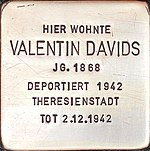 
|
| Location | Koelner Strasse 544 |
|
| Initiator, founder or client | Students of the Maria-Sibylla-Merian-Gymnasium | |
| financing | donate | |
| Date of first installation | November 19, 2008 | |
| Remarks | The stumbling blocks are reminiscent of:
Hedwig and Valentin Davids were deported to the Theresienstadt ghetto on July 25, 1942 . Valentin Davids died there on December 2, 1942. Hedwig Davids died there on May 15, 1943. |
|
Clementine Frank
| Clementine Frank | ||
|---|---|---|
| inscription | CLEMENTINE FRANK JG LIVED HERE . 1859 DEPORTED 1942 THERESIENSTADT DEAD 29.12.1942 |

|
| Location: | Breite Strasse 5 |
|
| Initiator, founder or client | ||
| financing | ||
| Date of first installation | November 19, 2008 | |
| Remarks | The stumbling block is reminiscent of Clementine Frank , born on August 24, 1859 in Krefeld.
Clementine Frank was deported to the Theresienstadt ghetto on July 25, 1942 , where she died on December 29, 1942. |
|
Klara Heymann
| Klara Heymann | ||
|---|---|---|
| inscription | KLARA HEYMANN GEB. LIVED HERE MEYER JG. DEPORTED 1888 1943 THERESIENSTADT AUSCHWITZ MURDERED 1944 |

|
| Location: | Angerhausenstrasse 14 |
|
| Initiator, founder or client | ||
| financing | ||
| Date of first installation | November 19, 2008 | |
| Remarks | The stumbling block is reminiscent of Klara Heymann geb. Meyer, born on March 22, 1888 in Krefeld.
Klara Heymann comes from a Jewish butcher family. Her first marriage was a non-Jew who fell in World War I. From this marriage there was a daughter. As a war widow and mother of a “ half-Jewish ” daughter, Klara Heymann initially enjoyed a certain protection. In her second marriage she married a Jew and had more children. When her son Werner left the city limits of Krefeld without permission, he was arrested immediately, which led to the deportation of his mother and son. Klara Heymann was deported to the Theresienstadt ghetto on June 25, 1943 and to the Auschwitz extermination camp on October 4, 1944 . Klara Heymann died there. Son Werner Heymann survived the Holocaust and later wrote a book about his memories. |
|
Max Hirsch and Johanna Hirsch
| Max Hirsch and Johanna Hirsch | ||
|---|---|---|
| Inscriptions | MAX HIRSCH JG LIVED HERE . 1873 ESCAPE 1939 HOLLAND DEPORTED AUSCHWITZ MURDERED 10/22/1942 JOHANNA HIRSCH GEB. LIVED HERE LEVY JG. 1874 ESCAPE 1939 HOLLAND DEPORTED AUSCHWITZ MURDERED 10/22/1942 |
 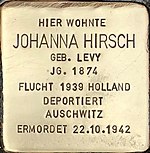
|
| Location: | Hochstrasse 62 (corner of Marktstrasse) |
|
| Initiator, founder or client | ||
| financing | ||
| Date of first installation | November 19, 2008 | |
| Remarks | The stumbling blocks are reminiscent of:
Max Hirsch was a businessman and married to Johanna Levy. Together they emigrated to the Netherlands in 1939. After the invasion of the German troops, they were from 3./5. Interned in Westerbork transit camp in October 1942 and deported together to Auschwitz on October 19, 1942 . On October 22, 1942, Max and Johanna Hirsch were pronounced dead. |
|
Meta Hirsch and Rudolf Hirsch
| Meta Hirsch and Rudolf Hirsch | ||
|---|---|---|
| Inscriptions | HERE LIVED META HIRSCH GEB. SAMSON JG. DEPORTED 1880 1942 THERESIENSTADT AUSCHWITZ MURDERED 1944 RUDOLF HIRSCH JG LIVED HERE . 1907 ESCAPED 1939 PALESTINE SURVIVED |
 
|
| Location: | Wilhelmshofallee 74 |
|
| Initiator, founder or client | ||
| financing | ||
| Date of first installation | November 19, 2008 | |
| Remarks | The stumbling blocks are reminiscent of:
Meta Hirsch was deported to the Theresienstadt ghetto on July 21, 1942 and from there to the Auschwitz extermination camp on October 9, 1944 . There you lose track of them ... Her son Rudolf Hirsch ran a small shoe shop, the Hirsch shoe store initially on the corner of Neumarkt and Hochstrasse, later the shop moved. As a communist and a Jew, he was exposed to the reprisals of the National Socialists at an early age. In 1938 he emigrated to Palestine . The Hirsch Schuhhaus was forcibly armed and taken over by an employee who belonged to the NSDAP . Even after 1945 Rudolf Hirsch did not get his business back; he was even refused entry into the British occupation zone . The new owner of the shoe store Grüterich claimed in court that "the shoe store would have been transferred because the owner had run down it so badly." ... In memory of Rudolf Hirsch, the Hirschgasse between Königstrasse and Lohstrasse was named after Rudolf Hirsch. |
|
Dr. Kurt Hirschfelder
| Dr. Kurt Hirschfelder | ||
|---|---|---|
| inscription | DR. KURT HIRSCHFELDER JG LIVED HERE . 1878 |
|
| Location: | East wall 148 |
|
| Initiator, founder or client | ||
| financing | ||
| Date of first installation | November 19, 2008 / relocation June 11, 2015 | |
| Remarks | The stumbling block reminds of Dr. Kurt Isidor Hirschfelder , born on March 11, 1878 in Rexingen .
Kurt Hirschfelder studied medicine at the universities of Freiburg , Munich and Berlin . In 1906 he was the first pediatrician to settle in Krefeld, where he set up a maternity care center. He lived and practiced in the Ostwall 148 house and in 1914 saw to the opening of an infant home for the Krefeld women's association in the house at Petersstrasse 71. During the First World War he was a medical officer. After the National Socialists came to power , his health insurance license was withdrawn in April 1933 and in December 1933 he had to relinquish the management of the infant home. After the pogrom night , Dr. Hirschfelder was forced to hand over his automobile and had to move to the house at Hohenzollernstrasse 46. In August 1941 he moved to Westwall 50. Before his deportation to the east, Dr. Kurt Hirschfelder ended his life on October 29, 1941. The Stolperstein originally laid on November 19, 2008, was accidentally destroyed during construction work on the east wall. On June 11, 2015, a new stumbling block was erected on the Ostwall in memory of Dr. Kurt Hirschfelder relocates. Due to renewed construction work on Ostwall 148, the Stolperstein is currently stored by the NS documentation center of the city of Krefeld (Villa Merländer). (As of February 2018) . |
|
Dr. Hugo Kaufmann, Georg Kaufmann and Erna Kaufmann
| Dr. Hugo Kaufmann, Georg Kaufmann and Erna Kaufmann | ||
|---|---|---|
| Inscriptions | DR. HUGO KAUFMANN JG LIVED HERE . 1873 DEPORTED 1942 THERESIENSTADT DEAD 17.2.1942 GEORG KAUFMANN JG LIVED HERE . 1921 ESCAPED 1939 ENGLAND SURVIVED ERNA KAUFMANN GEB. LIVED HERE KOOPMANN JG. DEPORTED 1882 1942 THERESIENSTADT AUSCHWITZ MURDERED 1944 |
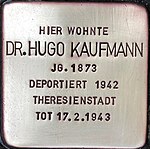  
|
| Location: | North wall 75 |
|
| Initiator, founder or client | ||
| financing | ||
| Date of first installation | November 19, 2008 | |
| Remarks | The stumbling blocks are reminiscent of:
Georg Kaufmann was able to emigrate to London on February 11, 1939 and survived the Holocaust . His parents Dr. Hugo Kaufmann and his wife Erna were deported to the Theresienstadt ghetto on July 25, 1942 . Hugo Kaufmann died on February 16, 1943 in the Theresienstadt ghetto . Erna Kaufmann died on October 9, 1944 in the Auschwitz extermination camp . |
|
Hermann Koppel
| Hermann Koppel | ||
|---|---|---|
| inscription | HERMANN KOPPEL JG LIVED HERE . 1856 DISTRIBUTED 'SANCTUARY' BENDORF-SAYN DEPORTED 1942 IZBICA MURDERED 1942 |

|
| Location | Kölner Strasse 25 |
|
| Initiator, founder or client | ||
| financing | ||
| Date of first installation | November 19, 2008 | |
| Remarks | The stumbling stone is reminiscent of Hermann Koppel , born on November 30, 1856 in Neukirchen-Vluyn .
The butcher Hermann Koppel was married to Josefine Voss and they had four children together (including daughter Else Koppel - see Else Müller Roßstrasse 249). Hermann Koppel married a second time. On June 19, 1908, he married Ida Winkler. Hermann Koppel was admitted to the Jewish sanatorium in Bendorf-Sayn on December 1, 1941 and deported from there to the Izbica ghetto on June 15, 1942 . His wife Ida was deported to the Theresienstadt ghetto in July 1942 on what is known as the transport of old people . |
|
Sara Koppel
| Sara Koppel | ||
|---|---|---|
| inscription | HERE LIVED SARA KOPPEL GEB. FALK JG. DEPORTED 1859 1942 IZBICA MURDERED |

|
| Location | Uerdinger Straße 109 (in front of the open space / parking lot) |
|
| Initiator, founder or client | ||
| financing | ||
| Date of first installation | November 19, 2008 | |
| Remarks | The stumbling block is reminiscent of Sara Klara Koppel nee. Falk, born on May 16, 1859 in Krefeld.
Sara Klara Koppel was deported to the Theresienstadt ghetto on July 25, 1942 and from there to the Treblinka extermination camp on September 21, 1942 . There you lose track of them ... Your son Hugo, who ran a company that imported oils and fats, was arrested after the November pogroms in 1938 and imprisoned in the Dachau concentration camp . In order to “ Aryanize ” his company , he was fired again. Hugo Koppel and his wife Hilde managed to emigrate to England with their daughter Marion in 1939 . He worked in Slough as an agent for a margarine factory. Hugo, Hilde and Marion Koppel survived the Holocaust . |
|
Wilhelm Rose
| Wilhelm Rose | ||
|---|---|---|
| Inscriptions | WILHELM ROSE JG LIVED HERE . 1938 DEPORTED 1940 AUSCHWITZ MURDERED 07/10/1943 |
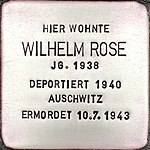
|
| Location | Glindholzstrasse 107 |
|
| Initiator, founder or client | ||
| financing | ||
| Date of first installation | November 19, 2008 / relocation February 2, 2018 | |
| Remarks | The stumbling stone is reminiscent of Wilhelm Rose , born on April 24, 1938 in Krefeld.
Wilhelm Rose was persecuted as a " gypsy " and deported to Auschwitz on May 21, 1943 in a collective transport . Wilhelm Rose was murdered on July 10, 1943 in the Auschwitz extermination camp . |
|
Ingeborg Zander, Karl Zander and Helga Zander
| Ingeborg Zander, Karl Zander and Helga Zander | ||
|---|---|---|
| Inscriptions | INGEBORG ZANDER JG LIVED HERE . DEPORTED 1923 1942 IZBICA MURDERED HERE LIVED KARL ZANDER JG. 1883 DEPORTED 1942 THERESIENSTADT AUSCHWITZ MURDERED 1944 HELGA ZANDER JG LIVED HERE . DEPORTED 1926 1942 IZBICA MURDERED |
  
|
| Location | Ostwall 48 (corner of Südwall) |
|
| Initiator, founder or client | ||
| financing | ||
| Date of first installation | November 19, 2008 | |
| Remarks | The stumbling blocks are reminiscent of:
Karl Zander was deported to the Theresienstadt ghetto on July 25, 1942 and from there to the Auschwitz extermination camp on October 6, 1944 , where his trace is lost ... His daughters Ingeborg and Helga were moved to the Izbica ghetto on April 22, 1942 deported, there is also no trace of them ... Helga and Ingeborg Zander were later declared dead. |
|
Willi Conrads
| Wilhelm Conrads | ||
|---|---|---|
| Inscriptions | WILLI CONRADS JG LIVED HERE . 1911 ASSIGNED 1935 SÜCHTELN-JOHANNISTHAL 'RELOCATED' 1941 HADAMAR MURDERED 1941 ACTION T4 |

|
| Location | Germaniastraße 51 (directly at the house entrance) |
|
| Initiator, founder or client | ||
| financing | ||
| Date of first installation | December 16, 2011 | |
| Remarks | The stumbling block is reminiscent of Wilhelm Conrads , born on August 9, 1911.
Wilhelm “Willi” Conrads was admitted to the Süchteln-Johannistal sanatorium and nursing home in 1935 because of schizophrenia and was transferred from there to Hadamar on June 30, 1941 . The obituary, with no exact date of death, was made on July 9, 1941. Wilhelm Conrads was murdered in July 1941 as part of Operation T4 . |
|
Bruno de Beer, Johanna de Beer, Ida de Beer and Rudolf de Beer
| Bruno de Beer, Johanna de Beer, Ida de Beer and Rudolf de Beer | ||
|---|---|---|
| Inscriptions | BRUNO DE BEER JG LIVED HERE . DEPORTED 1887 1942 IZBICA MURDERED HERE LIVED JOAN DE BEER GEB. KATZ JG. DEPORTED 1894 1942 IZBICA MURDERED IDA DE BEER JG LIVED HERE . DEPORTED 1922 1942 IZBICA MURDERED RUDOLF DE BEER JG LIVED HERE . DEPORTED 1925 1942 IZBICA MURDERED |
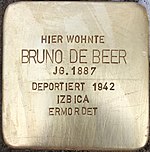   
|
| Location | Dießemer Straße 89 (in front of the entrance / driveway to the SpieDie playground ) |
|
| Initiator, founder or client | SPD Krefeld-Mitte | |
| financing | donate | |
| Date of first installation | December 16, 2011 / relocation February 2, 2018 | |
| Remarks | The stumbling blocks are reminiscent of:
Bruno de Beer ran a scrap dealer on the site at Dießemer Strasse 89. He was married to Johanna Katz and they had a son and a daughter together. Son Rudolf was an apprentice and daughter Ida worked in a household. Bruno de Beer was imprisoned in the Dachau concentration camp from November 17, 1938 to December 1, 1938 . On April 22, 1942, the entire family was deported to the Izbica ghetto . There their trail is lost. The de Beer family was declared dead on May 8, 1945 on April 12, 1950 by the Krefeld District Court. The partially badly damaged stumbling blocks from 2011 were completely removed as part of the seventh stumbling block laying in Krefeld on February 2, 2018 and replaced by four new stones. |
|
Moritz Frank
| Moritz Frank | ||
|---|---|---|
| inscription | MORITZ FRANK JG LIVED HERE . 1880 FORCED LABOR KREFELD TOT 08/22/1942 |

|
| Location | Lewerentzstrasse 21 (corner of Gerberstrasse) |
|
| Initiator, founder or client | ||
| financing | ||
| Date of first installation | December 16, 2011 | |
| Remarks | The stumbling block reminds of Moritz Frank , born on March 9, 1880 in Krefeld.
The merchant Moritz Frank was a co-owner of the silk shop Hertzmann and Frank on Neusser Strasse. Moritz Frank was married to the non-Jewish Klara Risse, and they had three children together before the First World War - Kurt, Herbert and Edith. In April 1933, daughter Ruth joined them. Moritz Frank was a soldier during the First World War and was wounded. After the November pogroms in 1938 , his sons Kurt and Herbert and his daughter Edith emigrated to East Africa. As a participant in the World War and through the so-called " mixed marriage ", Moritz Frank was protected from deportation, but was forced to do forced labor from March to August 1941 in the so-called "Jewish column" in the forest . Moritz Frank died ill and weak on August 22, 1942 in Krefeld. |
|
Erna Frankenberg and Else Frankenberg
| Erna Frankenberg and Else Frankenberg | ||
|---|---|---|
| Inscriptions | ERNA FRANKENBERG JG LIVED HERE . 1901 DEPORTED 1942 IZBICA ??? ELSE FRANKENBERG JG LIVED HERE . 1903 HUMILIATED / DISRUSTED ESCAPE TO DEATH April 20, 1942 |
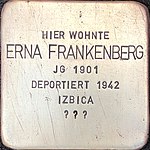 
|
| Location | Nordstrasse 15 |
|
| Initiator, founder or client | ||
| financing | ||
| Date of first installation | December 16, 2011 | |
| Remarks | The stumbling blocks are reminiscent of:
Else Frankenberg committed suicide in Krefeld on April 20, 1942 after the announcement of her deportation. Her sister Erna was deported to the Izbica ghetto on April 22, 1942 , where her trail is lost ... On May 8, 1945, Erna Frankenberg was declared dead by the Krefeld District Court in 1948. |
|
Anna Hermes
| Anna Hermes | ||
|---|---|---|
| inscription | ANNA HERMES JG LIVED HERE . 1919 DEPORTED 1943 AUSCHWITZ MURDERED 05/05/1943 |

|
| Location | Geldernsche Strasse 175 |
|
| Initiator, founder or client | ||
| financing | ||
| Date of first installation | December 16, 2011 | |
| Remarks | The stumbling block is reminiscent of Anna Hermes , born on October 2, 1919 in Krefeld.
Anna Hermes was deported to the Auschwitz extermination camp in 1942, where she died on May 5, 1943. |
|
Michael Levy, Rosa Levy, Max Levy, Paul Levy, Trude Levy, Hilde Levy and Erich Levy
| Michael Levy, Rosa Levy, Max Levy, Paul Levy, Trude Levy, Hilde Levy and Erich Levy | ||
|---|---|---|
| Inscriptions | MICHAEL LEVY JG LIVED HERE . DEPORTED 1870 1942 THERESIENSTADT MURDERED 02/12/1943 HERE LIVED ROSA LEVY GEB. GOLDBERG JG. DEPORTED 1864 1942 THERESIENSTADT MURDERED 13.8.1942 MAX LEVY JG LIVED HERE . DEPORTED 1899 1942 THERESIENSTADT MURDERED IN AUSCHWITZ PAUL LEVY JG LIVED HERE . 1904 ESCAPED 1937 SOUTH AFRICA SURVIVED HERE LIVED TRUDE LEVY GEB. MEYER JG. 1908 ESCAPED 1937 SOUTH AFRICA SURVIVED HERE LIVED Hilde LEVY GEB. BEHR JG. 1921 DEPORTED 1942 THERESIENSTADT BERGEN - BELSEN SURVIVED ERICH LEVY JG LIVED HERE . 1911 ESCAPED 1938 MEXICO SURVIVED |
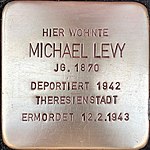      
|
| Location | Neusser Strasse 38 |
|
| Initiator, founder or client | ||
| financing | ||
| Date of first installation | December 16, 2011 | |
| Remarks | The stumbling blocks are reminiscent of:
Michael, Rosa, Hilde and Max Levy were deported to the Theresienstadt ghetto on July 25, 1942 . Rosa Levy died on August 13, 1942 and Michael Levy died on February 12, 1943 in the Theresienstadt ghetto . Max Levy was taken to the Auschwitz extermination camp on October 6, 1944 . There his track is lost. Max Levy was declared dead on May 8, 1945, 1950 by the Krefeld District Court. Hilde Levy survived the Bergen-Belsen concentration camp and returned to Krefeld for a short time on July 26, 1945. Paul and Trude Levy were able to emigrate to Johannesburg in South Africa on January 22, 1937 . Erich Levy was able to emigrate to Mexico on October 24, 1938. Paul, Trude and Erich Levy survived the Holocaust . |
|
Meta Joseph, Hedwig Willner, Irma de Vries, Liselotte Voss and Edith Willner
| Meta Joseph, Hedwig Willner, Irma de Vries, Liselotte Voss and Edith Willner | ||
|---|---|---|
| Inscriptions | HERE LIVED META JOSEPH GEB. WILLNER JG. 1909 DEPORTED 1941 RIGA ??? HEDWIG WILLNER GEB. LIVED HERE. PINS JG. 1883 DEPORTED 1941 RIGA MURDERED IN AUSCHWITZ in 1943 IRMA DE VRIES GEB. LIVED HERE WILLNER JG. 1911 ESCAPE 1938 HOLLAND INTERNED WESTERBORK DEPORTED 1942 MURDERED IN AUSCHWITZ 1943 LISELOTTE VOSS GEB. LIVED HERE WILLNER JG. 1912 ESCAPED 1938 RHODESIA SURVIVED EDITH WILLNER JG LIVED HERE . 1914 DEPORTED 1941 RIGA MURDERED IN STUTTHOF |
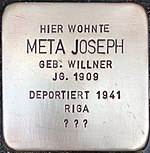   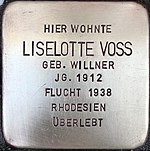 
|
| Location | Oelschlägerstrasse 63 |
|
| Initiator, founder or client | ||
| financing | ||
| Date of first installation | December 16, 2011 | |
| Remarks | The stumbling blocks are reminiscent of:
Hedwig Willner was deported to the Riga ghetto on December 11, 1941, together with her daughters Meta and Edith . From there they were taken to the Stutthof concentration camp on October 1, 1944 . Hedwig Willner died there on January 10, 1945. The seamstress Meta Joseph died presumably on December 27, 1944, was pronounced dead on December 31, 1945 by the Krefeld District Court in 1956. Edith Willner probably died in Stutthof after November 2, 1943, she was declared dead by the Krefeld District Court on December 31, 1945 in 1956. Irma de Vries was initially able to flee to Amsterdam, was interned in the Westerbork transit camp after the German troops marched in and deported to Auschwitz with her two-and-a-half-year-old daughter in 1942/43 . Irma de Vries probably died in the Sobibor extermination camp . On May 7, 1951, Irma de Vries was declared dead by the Uerdingen District Court on May 8, 1945. Liselotte Voss was in Rhodesia on July 26 of 1939 Buluwayo emigrate . In 1966 she was re-naturalized in Germany. |
|
Margarethe Papendell
| Margarethe Papendell | ||
|---|---|---|
| inscription | MARGARETH LIVED HERE PAPENDELL |

|
| Location | Inrather Straße at house number 145 (corner of Girmesdyk) |
|
| Initiator, founder or client | Lebenshilfe Krefeld eV | |
| financing | ||
| Date of first installation | December 16, 2011 | |
| Remarks | The stumbling block reminds of Margarethe Papendell , born on June 9, 1941 in Krefeld.
Margarethe Papendell was the youngest of 8 children of Elisabeth and Jakob Papendell. Due to a handicap of Margarethe caused by an accident, she was placed in the sanatorium in Bonn in 1943 and later transferred to the Waldniel children's department , a branch of the Süchteln sanatorium. When she was admitted, she was well fed and cared for. Margarethe died shortly after her second birthday due to "acute cardiac and circulatory weakness", according to the patient record. Historians assume that she did not die "normal" death. Her sister Rosemarie Mori, who was born in 1947, gave an indication of the reason for Margarethe's admission to the Westdeutsche Zeitung. “I remember that at home there was sometimes talk of a Jewish boy.” In a telephone conversation in the spring of 2013, her brother Jakob Papendell confirmed Rosemary's reference to the Jewish boy that his mother may have been hiding: Jakob Papendell, who has been for many Years ago in Australia: “Mother always made sandwiches for the Jewish children who were starving. We didn't have much ourselves, but they were even poorer. There was something about a little Jewish boy too. A married-in uncle threatened my mother with reporting her to the Gestapo if she continued to hide him. " |
|
Paul Vogt
| Paul Vogt | ||
|---|---|---|
| inscription | PAUL VOGT JG LIVED HERE . 1929 ADMISSIONED 1938 SANCTUARY WALDNIEL-HOSTERT 'KINDERFACHABTEILUNG' MURDERED 1943 |

|
| Location | Hohenzollernstrasse 2 (corner of Bismarckplatz) |
|
| Initiator, founder or client | ||
| financing | ||
| Date of first installation | December 16, 2011 | |
| Remarks | The stumbling block is reminiscent of Paul Vogt , born in Krefeld in 1929.
In 1938 Paul Vogt was assigned to the Waldniel children's department , a branch of the Süchteln sanatorium, where he died in 1943. |
|
Elfriede Bruckmann, Thekla Bruckmann, Olga Bruckmann, Albrecht Bruckmann, Mirijam Bruckmann, Anita Bruckmann, Jenny Bruckmann and Sara Marcus, Willy Marcus, Ingeborg Lotte Marcus
| Elfriede Bruckmann, Thekla Bruckmann, Olga Bruckmann, Albrecht Bruckmann, Mirijam Bruckmann, Anita Bruckmann, Jenny Bruckmann and Sara Marcus, Willy Marcus, Ingeborg Lotte Marcus | ||
|---|---|---|
| Inscriptions | ELFRIEDE LIVED HERE BRUCKMANN THEKLA BRUCKMANN JG LIVED HERE . DEPORTED 1890 1942 IZBICA MURDERED OLGA BRUCKMANN JG LIVED HERE . DEPORTED 1879 1942 IZBICA MURDERED ALBERT LIVED HERE BRUCKMANN MIRIJAM LIVED HERE BRUCKMANN ANITA BRUCKMANN JG LIVED HERE . DEPORTED 1922 1941 RIGA MURDERED JENNY BRUCKMANN JG LIVED HERE . DEPORTED 1932 1941 RIGA MURDERED SARA MARCUS GEB. LIVED HERE BRUCKMANN JG. DEPORTED 1886 1941 RIGA MURDERED WILLY MARCUS JG LIVED HERE . DEPORTED 1885 1941 RIGA MURDERED INGEBORG LOTTE LIVED HERE MARCUS |
  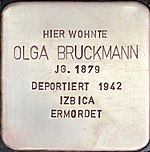 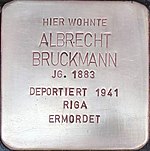   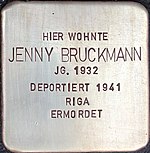   
|
| Location | South wall 34 |
|
| Initiator, founder or client | ||
| financing | ||
| Date of first installation | June 11, 2015 | |
| Remarks | The stumbling blocks are reminiscent of:
Albrecht Bruckmann was the son of the cattle dealer Salomon Bruckmann and his wife Maria Mayer. Albrecht Bruckmann became a silk goods dealer and after the First World War he founded a silk goods shop, which he and his brother Ludwig had been running in Haus Südwall 61 since 1925. In 1892 he married Mirijam Eisner and together they had children Anita, Rudolf and Jenny. After economic difficulties, the family moved to Copenhagen in June 1933. Son Rudolf (born in 1924) died there in February 1934. The Bruckmann family returned to Krefeld, where they lived in house Südwall 34 from June 1934. After the pogrom night in 1938 , Albrecht Bruckmann was arrested and imprisoned in the Dachau concentration camp . As a former front soldier, however, he was soon released. In September 1939 the family had to move to the “ Judenhaus ” at Hubertusstrasse 159, and on August 19, 1941 to the “Judenhaus” at Gerberstrasse 33. On December 11, 1941, the Bruckmann family was deported to the Riga ghetto . Her further fate is not known. Olga, Thekla and Elfriede Bruckmann were Albrecht Bruckmann's sisters. Olga Bruckmann was a housekeeper by profession , after a short stay in Breslau she returned to Krefeld in 1918. Thekla Bruckmann was a cleaner by profession and lived briefly in Geldern. Elfriede Bruckmann was a saleswoman by profession , but also worked in agriculture. Together with her brother Richard, the sisters founded Geschw. Bruckmann , a velvet and silk fabric business in 1919, which Brother Leopold joined in 1923 after Richard's departure. Leopold Bruckmann left the company again in 1927. Olga, Thekla and Elfriede Bruckmann moved the velvet and silk goods store to the house at Südwall 34, which belonged to their brother Albrecht. From 1929 they also lived there. In 1939 they were forced to give up their business and in April 1939 they moved to their parents' house at Hülser Strasse 404. Olga Bruckmann was housed in the Jewish sanatorium in Bendorf - Sayn from May to September 1940 . From there she returned to Krefeld. On April 22, 1942, the sisters were deported to the Izbica ghetto , where they are lost. Clara Bruckmann was also a Bruckmann sister. She was an office clerk and business owner. Clara Bruckmann went to Berlin in 1921, where she married Willy Marcus. Daughter Ingeborg Lotte was born there in 1923. In December 1933 Clara Bruckmann returned to Krefeld and moved to her siblings in the house at Südwall 34. Daughter Ingeborg Lotte and husband Willy followed in 1934. In 1938 daughter Ingeborg Lotte went to Switzerland to Montreux for half a year and returned on November 2, 1938 back to Krefeld to finally emigrate to England in the county of Essex on December 22, 1938. Clara Marcus and her husband, like their siblings, moved to the house at Hülser Strasse 404 in April 1939. On December 18, 1941, Willy and Clara Marcus were deported to Riga. There their trail is lost. The 10 stumbling blocks for the Jewish families Bruckmann and Marcus are currently the largest group of stumbling blocks in Krefeld. |
|
Elisabeth Erdtmann and Helga Erdtmann
| Elisabeth Erdtmann and Helga Erdtmann called Anja Lundholm | ||
|---|---|---|
| Inscriptions | ELISABETH LIVED HERE ERDTMANN HERE LIVED HELGA Erdtmann CALLED ANJA LUND HOLM JG. 1918 ESCAPE 1941 ITALY ARRESTED 1943 INNSBRUCK PRISON 1943 RAVENSBRÜCK RELEASED / SURVIVED |
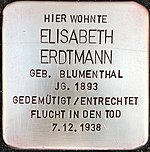 
|
| Location | Uerdinger Straße 1 (in front of Engel-Apotheke) |
|
| Initiator, founder or client | Students of the Ricarda-Huch-Gymnasium (Krefeld) | |
| financing | donate | |
| Date of first installation | June 11, 2015 | |
| Remarks | The stumbling blocks are reminiscent of:
Elisabeth Blumenthal came from a respected Jewish family from Darmstadt. She was married to the pharmacist Erich Erdtmann, who came from Upper Silesia. In 1913 the couple came to Krefeld, where Erich Erdtmann took over the Engel pharmacy. Daughter Helga was born on April 28, 1918. After 1933 Erich Erdtmann developed into a staunch National Socialist and harassed and humiliated his Jewish wife. According to reports from her daughter, Elisabeth Erdtmann committed suicide on December 7, 1938 . The daughter Helga Erdtmann fled to Italy in 1941 and joined a resistance group there. In 1943 she was arrested and taken to the Ravensbrück concentration camp via the Innsbruck prison . In April 1945 she managed to escape on one of the “ death marches ”. Helga Erdtmann survived the Holocaust and gained great fame as the writer Anja Lundholm . She died on August 4, 2007 in Frankfurt am Main . In the second half of April 2018, Elisabeth Erdtmann's stumbling block was stolen by strangers. On September 3, 2018, the missing stumbling block was replaced. |
|
Albert Italiander, Emma Italiander, Siegfried Italiander, Johanna Wyngaard and Martha Hildach
| Albert Italiander, Emma Italiander, Siegfried Italiander, Johanna Wyngaard and Martha Hildach | ||
|---|---|---|
| Inscriptions | HERE LIVED ALBERT ITALIA SANTANDER JG. 1860 DEPORTED 1942 THERESIENSTADT MURDERED 7.10.1943 HERE LIVED EMMA ITALIA SANTANDER GEB. GRÜNEWALD JG. DEPORTED IN 1865 1942 THERESIENSTADT LIBERATED / SURVIVED SIEGFRIED LIVED HERE ITALIANDER HERE LIVED JOHANNA Wyngaard GEB. ITALIANDER JG. 1893 DEPORTED 1941 RIGA 1944 STUTTHOF MURDERED 12/30/1944 HERE LIVED MARTHA Hildach GEB. ITALIANDER JG. DEPORTED IN 1895, 1944 THERESIENSTADT LIBERATED / SURVIVED |
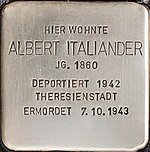   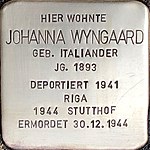 
|
| Location | Rheinstrasse 67 |
|
| Initiator, founder or client | ||
| financing | ||
| Date of first installation | June 11, 2015 | |
| Remarks | The stumbling blocks are reminiscent of:
Albert Italiander learned the profession of optician from his father and married Emma Grünwald in 1886. The couple had four children. Albert Italiander later became an antiques and art dealer and initially operated at Gerberstrasse 49, later at Ostwall 147. Albert Italiander was active in the Jewish community and directed the synagogue choir. Due to economic difficulties, the family moved to the apartment at Rheinstrasse 67 in 1935 and continued the art trade there in the two-room apartment. In 1939 he was forced to give up his business. In 1940 the family had to move to the " Judenhaus " at Bogenstrasse 73 and in 1941 to the "Judenhaus" at Neusser Strasse 63a. Albert and Emma Italiander were deported to the Theresienstadt ghetto on July 25, 1942 , where Albert Italiander died on October 7, 1942 (or February 7, 1943). The unmarried, second eldest son, Siegfried, was a commercial clerk and for a time an authorized signatory at the Hertzmann brothers' shoe polish factory . Daughter Martha married the Catholic dental technician Karl Hildach in 1924, and they had three children together. However, the marriage ended in divorce in 1937. Daughter Johanna married Oskar Wyngaard in November 1941. On December 11, 1941, Johanna was deported to the Riga ghetto with her husband and brother Siegfried . Martha Hildach was also deported to Theresienstadt in September 1944, where she met her mother again. Martha Hildach and Emma Italiander survived the Holocaust and returned to Krefeld in July 1945. Johanna Wyngaard was brought to the Stutthof concentration camp on October 1, 1944 , and died there on December 30, 1944. Her husband Oskar died in March 1944 in the Riga ghetto after severe abuse . The further fate of Siegfried Italiander is unknown. |
|
Bernhard Sommer and Helene Sommer
| Bernhard Sommer and Helene Sommer | ||
|---|---|---|
| Inscriptions | BERNHARD SOMMER JG LIVED HERE . 1888 DEPORTED 1941 ŁODZ / LITZMANNSTADT MURDERED 29.4.1942 HERE LIVED HELENE SOMMER GEB. MICHEL JG. 1885 DEPORTED 1941 ŁODZ / LITZMANNSTADT MURDERED 7.5.1942 CHELMNO / KULMHOF |
 
|
| Location | Seidenstrasse 45 (in front of the courtyard) |
|
| Initiator, founder or client | Liselotte Lenz, b. Summer (niece) | |
| financing | donate | |
| Date of first installation | June 11, 2015 | |
| Remarks | The stumbling blocks are reminiscent of:
Bernhard Sommer was a raw material dealer and married Helene Michel from Mainz in 1919. In 1927 he returned to Krefeld with his wife from Bottrop. The couple lived in the backyard at Seidenstrasse 45, together with their father Leopold Sommer. In 1941, the Sommer couple had to move to the “ Judenhaus ” in Neusser Strasse 63a. On October 27, 1941, they were deported to the Litzmannstadt ghetto . Bernhard Sommer died there on April 29, 1942. Helene Sommer was taken to the Kulmhof extermination camp on May 6, 1942 and murdered there on May 7, 1942. |
|
Marta Daniels, Kurt Daniels, Ruth Daniels and Werner Daniels
| Marta Daniels, Kurt Daniels, Ruth Daniels and Werner Daniels | ||
|---|---|---|
| Inscriptions | HERE LIVED MARTA DANIELS GEB. DAHL JG. DEPORTED 1886 1942 THERESIENSTADT MURDERED IN 1944 AUSCHWITZ KURT DANIELS JG LIVED HERE . 1913 ESCAPED 1939 BELGIUM 1940 FRANCE INTERNIERT GURS, DRANCY DEPORTED 1942 MURDERED IN AUSCHWITZ RUTH DANIELS JG LIVED HERE . 1914 ESCAPE 1939 ENGLAND WERNER DANIELS JG LIVED HERE . 1919 ESCAPED 1939 BELGIUM 1940 FRANCE INTERNED GURS 1942 MEMBER OF THE RESISTANCE |
   
|
| Location | Alte Krefelder Strasse 39 |
|
| Initiator, founder or client | ||
| financing | ||
| Date of first installation | February 16, 2016 | |
| Remarks | The stumbling blocks are reminiscent of:
Marta Daniels (née Dahl) was the widow of the cattle dealer Hermann Daniels, who died in 1932. Together they had the children Kurt, Ruth and Werner. Son Kurt had completed an apprenticeship in the textile trade and worked in various Jewish companies. Daughter Ruth had graduated from high school and worked as a secretary. Son Werner attended the secondary school at Moltkeplatz and received a scholarship when his mother could no longer afford the school fees. In February 1939 Werner Daniels was still able to do his Abitur. Ruth Daniels fled to England in 1939 and got a job as a nurse in London. Kurt and Werner Daniels fled to relatives in Belgium in March 1939, a few weeks apart. Mother Marta Daniels moved to Wuppertal in 1942 to take care of her brother, who was blind in the First World War . Marta Daniels was deported to the Theresienstadt ghetto in the same year and from there to the Auschwitz extermination camp in 1944 . There she was murdered in 1944. Kurt and Werner Daniels fled to southern France after the invasion of the German troops and were interned there as "undesirable foreigners" in the Camp de Gurs . Kurt Daniels was brought to Auschwitz via the Drancy assembly camp , where he was murdered in 1942. Werner Daniels was able to escape from the internment camp and joined the Resistance under the name René Dizier . Ruth and Werner Daniels survived the Holocaust and never returned to Germany. |
|
Alfred Goldstein, Erna Goldstein, Edgar Goldstein and Friedrich-Josef Wihl
Max Gompertz, Ilse Gompertz, Georg Gompertz, Ruth Gompertz and Esther Gompertz
| Max Gompertz, Ilse Gompertz, Georg Gompertz, Ruth Gompertz and Esther Gompertz | ||
|---|---|---|
| Inscriptions | MAX GOMPERTZ JG LIVED HERE . 1,869 deported in 1942 THERESIENSTADT 1942 TREBLINKA MURDERED HERE LIVED ILSE GOMPERTZ GEB. NEUSTADT JG. 1,892 deported in 1942 THERESIENSTADT 1942 TREBLINKA MURDERED GEORG GOMPERTZ JG LIVED HERE . 1904 ESCAPE 1938 SHANGHAI HERE LIVED RUTH GOMPERTZ VERH. HILLS JG. 1911 ESCAPED 1938 AUSTRALIA ESTHER GOMPERTZ VERH LIVED HERE. DEVRIES JG. 1919 ESCAPED 1938 AUSTRALIA |
    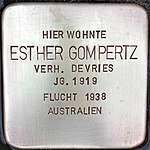
|
| Location | Uerdinger Straße 412 (in Schönhausenpark, below a showcase) |
|
| Initiator, founder or client | The house owner of Villa Schönhausen, Gerald Wagener, donated four stumbling blocks, and the fifth stumbling block was donated by students from the Ricarda Huch School . | |
| financing | donate | |
| Date of first installation | February 16, 2016 | |
| Remarks | The stumbling blocks are reminiscent of:
The hat manufacturer Max Gompertz was married to Rosa Spanier and they had four children together. His wife died in 1916. His second marriage was to Ilse Gompertz. In 1918 they acquired the Schönhausen villa . In 1919 daughter Ruth was born. Due to economic difficulties, they had to sell their property to the city of Krefeld in 1932/33, but were able to stay there until 1936. While the children Ruth, Georg and Esther were able to emigrate , the parents Max and Ilse first moved to Elisabethstraße and in 1941 were forced to move to the ghetto building at Stadtgarten 12. Max and Ilse Gompertz were deported to the Theresienstadt ghetto on July 25, 1942 and to the Treblinka extermination camp on September 26, 1942 . Max and Ilse Gompertz were later pronounced dead. The two daughters from their first marriage did not survive the Holocaust either. Henriette Bernheim (née Gompertz) was murdered in Auschwitz-Birkenau . Klara Stern (née Gompertz) committed suicide after the deportation order was served. |
|
Max Mayer, Rosel Mayer, Ruth Mayer, Alfred Mayer and Doris Mayer
| Max Mayer, Rosel Mayer, Ruth Mayer, Alfred Mayer and Doris Mayer | ||
|---|---|---|
| Inscriptions | MAX MAYER JG LIVED HERE . 1896 'PROTECTIVE' 1938 DACHAU DEPORTED 1941 ŁODZ / LITZMANNSTADT 1944 BERGEN-BELSEN LIBERATED DEAD 13.5.1945 HERE LIVED ROSEL MAYER GEB. MERCHANT JG. 1,896 deported in 1941 Lodz / LITZMANNSTADT 1944 AUSCHWITZ MURDERED 1945 STUTTHOF RUTH MAYER JG LIVED HERE . 1921 DEPORTED 1941 ŁODZ / LITZMANNSTADT 1944 CHELMNO / KULMHOF MURDERED July 11, 1944 ALFRED MAYER JG LIVED HERE . 1924 DEPORTED 1941 ŁODZ / LITZMANNSTADT 1944 BUCHENWALD OUTSIDE CAMPING RELEASED DORIS MAYER JG LIVED HERE . 1924 DEPORTED 1941 ŁODZ / LITZMANNSTADT 1944 AUSCHWITZ STUTTHOF MURDERED AUG. 1944 |
    
|
| Location | Bruchstraße 31 (in front of the open space / parking lot) |
|
| Initiator, founder or client | ||
| financing | ||
| Date of first installation | February 16, 2016 | |
| Remarks | The stumbling blocks are reminiscent of:
The married couple Max and Rosel Mayer originally lived in Lank, where their children Ruth, Alfred and Doris were born. In 1930 Max Mayer opened his own shop in Uerdingen. His wife Rosel, a trained cleaner , stood behind the counter as a “helping family member”. Max Mayer was arrested during the November pogroms in 1938 and imprisoned in Dachau concentration camp on November 17, 1938 . On December 10, 1938, he was released from the camp to sell his business. Then Max Mayer had to do forced labor in civil engineering. The Mayer family was deported to the Łódź / Litzmannstadt ghetto on October 27, 1941 . Shortly before the Łódź / Litzmannstadt ghetto was dissolved, the Mayer family was deported to concentration camps. Max Mayer was sent to the Auschwitz extermination camp in August 1944 and then to the Bergen-Belsen concentration camp there, after his liberation, on May 13, 1945. |
|
Karl Merländer and Richard Merländer
| Karl Merländer and Richard Merländer | ||
|---|---|---|
| Inscriptions | HERE LIVED KARL Merländer JG. 1867 VICTIM OF THE 1938 POGROME ABUSED DEAD OF THE CONSEQUENCES 25.12.1938 HERE LIVED RICHARD Merländer JG. 1,874 deported in 1942 THERESIENSTADT 1942 TREBLINKA MURDERED |
 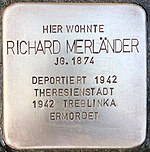
|
| Location | Friedrich-Ebert-Straße 42 (in front of Villa Merländer ) |
|
| Initiator, founder or client | ||
| financing | ||
| Date of first installation | February 16, 2016 | |
| Remarks | The stumbling blocks are reminiscent of:
Richard and Samuel Merländer were the sons of the businessman Bendix Merländer (1833-1897) and his wife Johanne Levy (1834-1911). Together they had two sisters (Charlotte, born in 1866 and Helene, born in 1869) and one more brother (Max, born in 1871). The parents ran a haberdashery shop in Mülheim, and later a shop for women's ready-to-wear goods . Richard Merländer became a merchant like his father and founded the velvet and silk wholesaler Merländer, Strauss & Co in 1904 together with Siegfried Strauss and Hermann Heymann . In 1905 Richard Merländer moved from Mülheim to Krefeld. Between 1924 and 1925 Richard Merländer had the " Villa Merländer " built as his private residence on Friedrich-Ebert-Straße in Krefeld. Merländer had one room in the new house decorated with wall paintings by the Krefeld artist Heinrich Campendonk . Around 1928 his brother Samuel, who had his name changed to Karl, moved to the Villa Merländer as a pensioner . Karl Merländer had previously worked as a representative in Berlin. Because Richard Merländer was gay and of Jewish descent, he was persecuted by the National Socialists after 1933 . In 1938 Richard Merländer had to give up his company; his property was confiscated. During the November pogroms in 1938 , Villa Merländer was devastated and the brothers mistreated. Karl Merländer suffered a "torn heart ligament" and died on December 25, 1938 in the Uerdingen hospital as a result of the pogrom night. He left a son (Kurt, born in 1898) who was later able to emigrate . Richard Merländer finally had to sell his house, but he could not freely dispose of the proceeds either. In 1941 he therefore had to move into the " Judenhaus " at Bismarckstrasse 118 and on July 23, 1942, to a room in the guesthouse at Hubertusstrasse 68. A last letter from Richard Merländer to his partner Ludwig Hagemes in Berlin has been received from this address. Richard Merländer was deported to the Theresienstadt concentration camp on July 25, 1942 and murdered in the Treblinka extermination camp in September 1942 . By order of the Krefeld District Court on December 11, 1950, Richard Merländer was declared dead on May 8, 1945. |
|
Heinrich Plum
| Heinrich Plum | ||
|---|---|---|
| inscription | HEINRICH PLUM JG LIVED HERE . 1903 IM WIDERSTAND / KPD 'SCHUTZHAFT' 1933 JUDGE ANRATH 1934 JUDGE LÜTTRIGHAUSEN, CELLE 1939 BUCHENWALD liberated |

|
| Location | Lohstrasse 58/60 |
|
| Initiator, founder or client | ||
| financing | ||
| Date of first installation | February 16, 2016 | |
| Remarks | The stumbling block reminds of Heinrich Plum , born on October 6, 1903.
The worker Heinrich (Heiner) Plum was a servant and later a stone maker. As a member and political leader of the KPD , he was placed under “ protective custody ” and interned in 1933 . In September of the same year he was released on "word of honor". However, his further work in the communist resistance was betrayed and he was sentenced to prison. He served his sentence in the penitentiaries of Anrath , Lüttringhausen and Celle . After his release in 1939, he was arrested again directly by the Gestapo at Krefeld train station and deported to the Buchenwald concentration camp . Several of his requests for release were denied. In 1945 he was liberated by American soldiers. Heinrich (Heiner) Plum suffered badly from the consequences of imprisonment and died on 24/25. August 1950 in Krefeld. |
|
Dr. Ernst Ascher
| Dr. Ernst Ascher | ||
|---|---|---|
| inscription | DR. ERNST ASCHER JG LIVED HERE . 1876 BANNED PROFESSION 1938 DEPORTED 1942 THERESIENSTADT 1944 AUSCHWITZ MURDERED |

|
| Location | Hohenzollernstrasse 24 |
|
| Initiator, founder or client | ||
| financing | ||
| Date of first installation | May 8, 2017 | |
| Remarks | The stumbling stone is reminiscent of Ernst Ascher , born on January 12, 1876 in Jastrow .
The doctor Dr. Ernst Ascher's license to practice medicine was revoked in 1938 and he was banned from working . On July 25, 1942, he was deported to the Theresienstadt ghetto and on May 15, 1944 to the Auschwitz extermination camp . There his track is lost ... |
|
Hermann Goldschmidt and Jeanette Goldschmidt
| Hermann Goldschmidt and Jeanette Goldschmidt | ||
|---|---|---|
| Inscriptions | HERMANN GOLDSCHMIDT JG LIVED HERE . DEPORTED 1872 1942 THERESIENSTADT MURDERED December 16, 1943 HERE LIVED JEANETTE Goldschmidt GEB. LEVEN JG. 1866 HUMILIATED / Disenfranchised TOT 10/22/1939 |
 
|
| Location | Niederstrasse 38 |
|
| Initiator, founder or client | ||
| financing | ||
| Date of first installation | May 8, 2017 | |
| Remarks | The stumbling blocks are reminiscent of:
Hermann Goldschmidt was married to Jeanette Leven. His wife Jeanette Goldschmidt died on October 22, 1939 and was buried in the Jewish cemetery. The widower Hermann Goldschmidt was deported to the Theresienstadt ghetto in 1942, where he died on December 16, 1943. |
|
Auguste Hertz
| Auguste Hertz | ||
|---|---|---|
| inscription | AUGUSTE HERTZ JG LIVED HERE . 1859 DEPORTED 1942 THERESIENSTADT MURDERED September 23, 1942 |
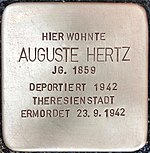
|
| Location | North wall 80 |
|
| Initiator, founder or client | Pastor Goll from Switzerland | |
| financing | donate | |
| Date of first installation | May 8, 2017 | |
| Remarks | The stumbling block is reminiscent of Auguste Hertz , born on August 15, 1859 in Krefeld.
The unmarried Auguste Hertz was deported to the Theresienstadt ghetto on July 25, 1942 . There she died of exhaustion on September 23, 1942. |
|
Anna Herz, Hedwig Herz, Hermann Herz, Elisabeth Herz and Antonie Coppel, Alfred Coppel
| Anna Herz, Hedwig Herz, Hermann Herz, Elisabeth Herz and Antonie Coppel, Alfred Coppel | ||
|---|---|---|
| Inscriptions | HERE LIVED ANNA HEART GEB. MERCHANT JG. 1,873 deported in 1942 THERESIENSTADT 1942 TREBLINKA MURDERED HERMANN HERZ JG LIVED HERE . DEPORTED 1899 1942 IZBICA MURDERED HERE LIVED ELISABETH HEART GEB. KATZ JG. DEPORTED 1902 1942 IZBICA MURDERED HERE LIVED ANTONIE COPPEL GEB. HEART JG. 1903 DEPORTED 1941 ŁODZ / LITZMANNSTADT 1944 AUSCHWITZ MURDERED 1.12.1944 STUTTHOF ALFRED COPPEL JG LIVED HERE . 1909 DEPORTED 1941 ŁODZ / LITZMANNSTADT 1944 AUSCHWITZ MURDERED November 15, 1944 DACHAU HEDWIG HERZ JG LIVED HERE . 1916 ESCAPE 1939 ENGLAND |
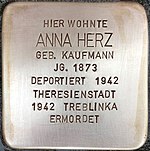 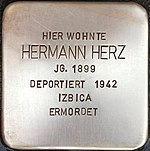 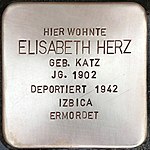   
|
| Location | Bahnhofstrasse 48 |
|
| Initiator, founder or client | ||
| financing | ||
| Date of first installation | May 8, 2017 | |
| Remarks | The stumbling blocks are reminiscent of:
|
|
Rudolf Müller and Sophie Müller
| Rudolf Müller and Sophie Müller | ||
|---|---|---|
| Inscriptions | HERE LIVED RUDOLF MÜLLER JG. 1868 ESCAPE 1939 HOLLAND INTERNED WESTERBORK DEPORTED 1943 SOBIBOR MURDERED 1943 SOPHIE MÜLLER GEB. LIVED HERE HIRSCH JG. 1877 ESCAPE 1939 HOLLAND INTERNED WESTERBORK DEPORTED 1943 SOBIBOR MURDERED 1943 |
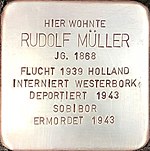 
|
| Location | Hohenzollernstrasse 79 |
|
| Initiator, founder or client | ||
| financing | ||
| Date of first installation | May 8, 2017 | |
| Remarks | The stumbling blocks are reminiscent of:
The Krefeld tie manufacturer Rudolf Müller and his wife Sophie experienced the November pogroms in 1938 in their own house at Hohenzollernstrasse 79. Their furniture and dishes were smashed and thrown out of the windows, pictures cut up. The tie factory then had to be forcibly sold . With the help of her son, she could in the Netherlands on 1 August 1939 to emigrate . After the occupation by the German troops, they were interned in the Westerbork transit camp and deported to the Sobibor extermination camp on July 6, 1943 . They died there on July 9, 1943. |
|
Leopold Spanier and Rosa Spanier
| Leopold Spanier and Rosa Spanier | ||
|---|---|---|
| Inscriptions | LEOPOLD SPANIER JG LIVED HERE . 1871 ESCAPE 1939 HOLLAND INTERNED WESTERBORK DEPORTED 1943 SOBIBOR MURDERED 1943 HERE LIVED ROSA SPANISH BORN LEVEN JG. 1877 ESCAPE 1939 HOLLAND INTERNED WESTERBORK DEPORTED 1943 SOBIBOR MURDERED 1943 |
 
|
| Location | Hohenzollernstrasse 46 |
|
| Initiator, founder or client | ||
| financing | ||
| Date of first installation | May 8, 2017 | |
| Remarks | The stumbling blocks are reminiscent of:
Rosa and Leopold Spanier's lease for their business was terminated by the city of Krefeld in 1937, and a little later they also lost their apartment at Hohenzollernstrasse 46. On January 9, 1939, the couple fled to the Netherlands. After the occupation by the German troops, they were interned in the Westerbork transit camp and deported to the Sobibor extermination camp on May 4, 1943 . They died there on May 7, 1943. |
|
Peter Jöcken
Hermann Ems, Klara Ems and Kurt Ems
| Hermann Ems, Klara Ems and Kurt Ems | ||
|---|---|---|
| Inscriptions | HERMANN EMS JG LIVED HERE . 1873 ESCAPED TO DEATH BEFORE DEPORTATION July 14, 1942 KLARA EMS GEB. LIVED HERE BERG JG. 1890 BEFORE DEPORTATION ESCAPE TO DEATH July 14, 1942 HERE LIVED KURT EMS JG. 1915 ESCAPE 1938 COLOMBIA |
  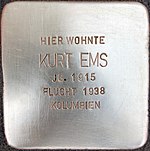
|
| Location | Steinstrasse 121 |
|
| Initiator, founder or client | ||
| financing | ||
| Date of first installation | February 2, 2018 | |
| Remarks | The stumbling blocks are reminiscent of:
|
|
Eduard Baruch and Siegfried Baruch
| Eduard and Siegfried Baruch | ||
|---|---|---|
| inscription | HERE LIVED EDWARD BARUCH JG. DEPORTED IN 1892 1941 RIGA MURDERED HERE LIVED SIEGFRIED BARUCH SIDNEY BROOK JG. 1920 ESCAPE 1939 ENGLAND |
 
|
| Location | Hülser Strasse 15 |
|
| Initiator, founder or client | ||
| financing | ||
| Date of first installation | February 2, 2018 | |
| Remarks | The stumbling blocks are reminiscent of:
|
|
Siegmund Zanders, Maria Anna Zanders, Edith Zanders, Kurt Zanders and Helmut Zanders
Lisette Heinemann, Max Heinemann, Erich Heinemann and Herbert Heinemann
Emilie Meyer, Karl Meyer, Martha Meyer, Ruth Meyer and Ilse Meyer
| Emilie, Karl, Martha, Ruth and Ilse Meyer | ||
|---|---|---|
| Inscriptions | HERE LIVED EMILIE MEYER GEB. SERVOS JG. 1859 DEPORTED 1942 THERESIENSTADT 1942 TREBLINKA MURDERED SEPT. 1942 HERE LIVED KARL MEYER JG. 1888 ESCAPE 1939 ENGLAND MARTHA MEYER GEB. LIVED HERE MEYER JG. 1897 ESCAPE 1939 ENGLAND RUTH MEYER JG LIVED HERE . 1921 ESCAPE 1939 ENGLAND ILSE MEYER JG LIVED HERE . 1924 ESCAPE 1939 ENGLAND |
    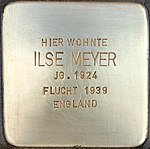
|
| Location | Friedrich-Ebert-Strasse 23 |
|
| Initiator, founder or client | ||
| financing | ||
| Date of first installation | February 2, 2018 | |
| Remarks | The stumbling blocks are reminiscent of:
|
|
Alfred Lorant, Bertha Lorant, Inge Lorant and Amalie Schaffrath, Ernst Schaffrath, Edith Schaffrath, Karl Schaffrath, Regine Schaffrath
Johannes Winkels
Jakob Lücker
Carl Becker
August Kaiser
Josefa Flock
Johannes Böckling
Agnes Barsdorf, Irma Barsdorf, Julius Grünberg and Olga Grünberg
Web links
- List of stumbling blocks sorted by name (pdf) (as of July 2017, 118 stumbling blocks)
- Stumbling block list sorted by street (pdf) (as of May 2017, 118 stumbling blocks)
- Geoportal of the Stolpersteine in the city of Krefeld
- Download the data of all stumbling blocks in the Open Data Portal of the city of Krefeld
Individual evidence
- ↑ Westdeutsche Zeitung March 24, 2006: Stumbling blocks: compromise found
- ↑ Article of November 29, 2008 ( Memento of February 16, 2015 in the Internet Archive )
- ↑ rp-online.de (from December 12, 2006): First stumbling blocks remind of Nazi victims , accessed on June 11, 2017
- ^ Bundesarchiv.de: memorial book entry Müller, Else
- ^ School newspaper of the Kurt-Tucholsky-Gesamtschule Krefeld ( Memento from February 16, 2015 in the Internet Archive )
- ↑ a b villamerlaender.de: IV_2016 | Rossstrasse 249 | For Else Müller , accessed June 12, 2017
- ↑ villamerlaender.de: VI_2016 | Paula Billstein | Ritterstrasse 189 , accessed on June 17, 2017
- ↑ bundesarchiv.de: memorial book entry Frank, Eugen
- ^ Bundesarchiv.de: memorial book entry Frank, Luise
- ↑ Krefeld Jews. Krefeld Studies 2, 1981, page 290
- ^ Bundesarchiv.de: entry in the memorial book of Daniels, Arthur
- ^ Bundesarchiv.de: entry in the memorial book of Daniels, Marta
- ↑ Jews in the time of National Socialism, Krefeld 1988, page 98 and Krefeld Jews. Krefeld Studies 2, 1981, p. 281.
- ^ Bundesarchiv.de: entry in the memorial book of Daniel, Jakob
- ^ Bundesarchiv.de: memorial book entry Daniel, Luise
- ^ Bundesarchiv.de: entry in the memorial book of Daniel, Hans
- ↑ Krefeld Jews. Krefeld Studies 2, 1981, p. 281.
- ↑ a b c d NS documentation center of the city of Krefeld, Dr. Ingrid Schupetta
- ^ Bundesarchiv.de: memorial book entry Alexander, Ruth
- ^ Bundesarchiv.de: entry in the memorial book of Alexander, Olga
- ^ Bundesarchiv.de: memorial book entry Alexander, Ilse
- ↑ Krefeld Jews. Krefelder Studien 2, 1981, pp. 262 and 386.
- ^ Bundesarchiv.de: Gedenkbuch entry Dannenberg, Josef Joseph
- ^ Bundesarchiv.de: memorial book entry Dannenberg, Else
- ^ Bundesarchiv.de: entry in the memorial book of David, Berta
- ↑ Werner Mellen: Jews in Krefeld-Hüls. Krefeld 2003, ISBN 3-935526-04-0
- ^ Bundesarchiv.de: entry in the memorial book of Davids, Valentin
- ↑ bundesarchiv.de: entry in the memorial book of Davids, Hedwig
- ^ Bundesarchiv.de: memorial book entry Frank, Clementine
- ^ Bundesarchiv.de: memorial book entry Heymann / van Hoffs, Klara
- ↑ spd-krefeld.de: Stolpersteine in Krefeld - tour with Dr. Ingrid Schupetta ( Memento of the original from June 10, 2017 in the Internet Archive ) Info: The archive link was inserted automatically and has not yet been checked. Please check the original and archive link according to the instructions and then remove this notice. , accessed June 11, 2017
- ↑ bundesarchiv.de: entry in the Hirsch memorial book, Max
- ^ Bundesarchiv.de: entry in the memorial book of Hirsch, Johanna
- ^ Bundesarchiv.de: entry in the Hirsch memorial book, Meta
- ↑ Anti-fascist city tour 2011 (PDF), accessed on June 16, 2017
- ^ Bundesarchiv.de: entry in the Hirschfelder memorial book, Kurt Isidor
- ↑ rp-online.de (from June 12, 2015): The Jewish doctor Kurt Hirschfelder , accessed on June 15, 2017
- ↑ rp-online.de (from June 11, 2015): Memorial stones for Nazi victims: artist should pay a fee of 26 euros to the city , accessed on June 15, 2017
- ^ Bundesarchiv.de: entry in the memorial book of Kaufmann, Hugo
- ^ Bundesarchiv.de: Gedenkbuch entry Kaufmann, Erna
- ^ Bundesarchiv.de: memorial book entry Koppel, Hermann
- ^ Bundesarchiv.de: memorial book entry Koppel, Sara Clara Klara
- ^ Bundesarchiv.de: Zander memorial book entry, Karola Ingeborg Carla Inge
- ↑ bundesarchiv.de: entry in the Zander, Karl memorial book
- ↑ bundesarchiv.de: Zander, Helga memorial book entry
- ^ Bundesarchiv.de: memorial book entry Beer, Bruno de
- ^ Bundesarchiv.de: memorial book entry Beer, Johanna de
- ^ Bundesarchiv.de: memorial book entry Beer, Ida de
- ^ Bundesarchiv.de: memorial book entry Beer, Rudolf Rudi de
- ↑ spd-krefeld-mitte.de (from December 19, 2011): SPD-Mitte board members assume sponsorship for stumbling blocks , accessed on June 15, 2017
- ↑ villamerlaender.de: Lewerentzstr. 21 | The story of Moritz Frank , accessed on June 12, 2017
- ^ Bundesarchiv.de: entry in the Frankenberg memorial book, Erna
- ↑ bundesarchiv.de: entry in the Frankenberg, Else memorial book
- ^ Bundesarchiv.de: entry in the memorial book Hermes, Anna
- ^ Bundesarchiv.de: memorial book entry Levy, Michael
- ^ Bundesarchiv.de: memorial book entry Levy, Rosa
- ^ Bundesarchiv.de: memorial book entry Levy, Max
- ^ Bundesarchiv.de: memorial book entry Levy, Max
- ^ Bundesarchiv.de: entry in the memorial book Joseph, Meta
- ^ Bundesarchiv.de: memorial book entry Willner, Hedwig
- ^ Bundesarchiv.de: Memorial book entry Willner, Edith
- ^ Egon Traxler: A stumbling block also reminds us of the bombing inferno 70 years ago in June 1943. - Die Heimat, pp. 138–141; Krefeld 2012
- ^ Bundesarchiv.de: memorial book entry Bruckmann, Elfriede
- ^ Bundesarchiv.de: memorial book entry Bruckmann, Thekla
- ^ Bundesarchiv.de: memorial book entry Bruckmann, Olga
- ^ Bundesarchiv.de: memorial book entry Bruckmann, Albrecht
- ^ Bundesarchiv.de: Bruckmann, Mirjam memorial book entry
- ^ Bundesarchiv.de: memorial book entry Bruckmann, Anita
- ^ Bundesarchiv.de: Bruckmann, Jenny memorial book entry
- ↑ rp-online.de (from June 12, 2015): Seidenweberfamilie Bruckmann , accessed on June 10, 2017
- ↑ rp-online.de (from February 15, 2017): Memories of Anja Lundholm , accessed on June 10, 2017
- ↑ rp-online.de (from June 12, 2015): The pharmacist Elisabeth Erdtmann , accessed on June 10, 2017
- ↑ http://www.wz.de/lokales/krefeld/der-verschwundene-stolperstein-von-elisabeth-erdtmann-1.2758924
- ↑ bundesarchiv.de: commemorative book entry Italia Santander, Albert
- ↑ bundesarchiv.de: commemorative book entry Italia Santander, Siegfried
- ↑ bundesarchiv.de: commemorative book entry Wyngaard, Johanna
- ↑ rp-online.de (from June 12, 2015): Italiander family - committed Jews , accessed on June 9, 2017
- ↑ bundesarchiv.de: entry in the summer memorial book, Bernhard
- ^ Bundesarchiv.de: Memorial book entry summer, Helene
- ↑ rp-online.de (from June 12, 2015): Stones against forgetting , accessed on June 11, 2017
- ^ Bundesarchiv.de: entry in the memorial book of Daniels, Kurt
- ↑ a b rp-online.de (from February 15, 2016): artist relocates stones in memory of Nazi victims , accessed on June 5, 2017
- ^ Bundesarchiv.de: memorial book entry Goldstein, Alfred
- ^ Bundesarchiv.de: entry in the memorial book Wihl, Friedrich Joseph Josef
- ^ Bundesarchiv.de: memorial book entry Gompertz, Max Rudi
- ^ Bundesarchiv.de: Gompertz, Ilse memorial book entry
- ↑ rp-online.de (from February 17, 2016): Uerdingen's first stumbling blocks , accessed on June 5, 2017
- ↑ villamerlaender.de: Stolpersteine für Krefeld , accessed on June 5, 2016
- ^ Bundesarchiv.de: memorial book entry Mayer, Max
- ^ Bundesarchiv.de: memorial book entry Mayer, Rosel Rosalie
- ^ Bundesarchiv.de: memorial book entry Mayer, Ruth
- ^ Bundesarchiv.de: memorial book entry Mayer, Doris
- ↑ villamerlaender.de: Stolpersteine für Krefeld , accessed on June 5, 2016
- ↑ bundesarchiv.de: commemorative book entry Merländer, Richard
- ↑ Ingrid Schupetta: Richard Merländer, silk merchant from Krefeld - research on a stranger (PDF), accessed on June 16, 2017
- ^ Bundesarchiv.de: memorial book entry Ascher, Ernst
- ↑ a b c d rp-online.de (from May 9, 2017): Stumbling blocks for the questions of young people , accessed on June 5, 2017
- ^ Bundesarchiv.de: memorial book entry Goldschmidt, Hermann
- ^ Bundesarchiv.de: entry in the memorial book Hertz, Auguste Sara
- ^ Bundesarchiv.de: memorial book entry Herz, Anna
- ^ Bundesarchiv.de: Memorial book entry Herz, Hermann
- ^ Bundesarchiv.de: memorial book entry Coppel, Alfred
- ^ Bundesarchiv.de: Coppel, Antonie memorial book entry
- ↑ bundesarchiv.de: memorial book entry Müller, Rudolf Rudolph
- ^ Bundesarchiv.de: memorial book entry Müller, Sophie Sofie
- ↑ bundesarchiv.de: entry in the Spanish memorial book, Rosa Ruth
- ^ Bundesarchiv.de: entry in the memorial book Spanier, Leopold
- ^ Bundesarchiv.de: Ems, Hermann memorial book entry
- ^ Bundesarchiv.de: memorial book entry Ems, Klara
- ^ Bundesarchiv.de: entry in the memorial book of Baruch, Eduard
- ^ Bundesarchiv.de: Zanders memorial book entry, Siegmund Sigmund
- ^ Bundesarchiv.de: Zanders memorial book entry, Maria Anna Marianne
- ^ Bundesarchiv.de: Zanders memorial book entry, Helmuth Hermann
- ^ Bundesarchiv.de: entry in the memorial book of Meyer, Emilie






